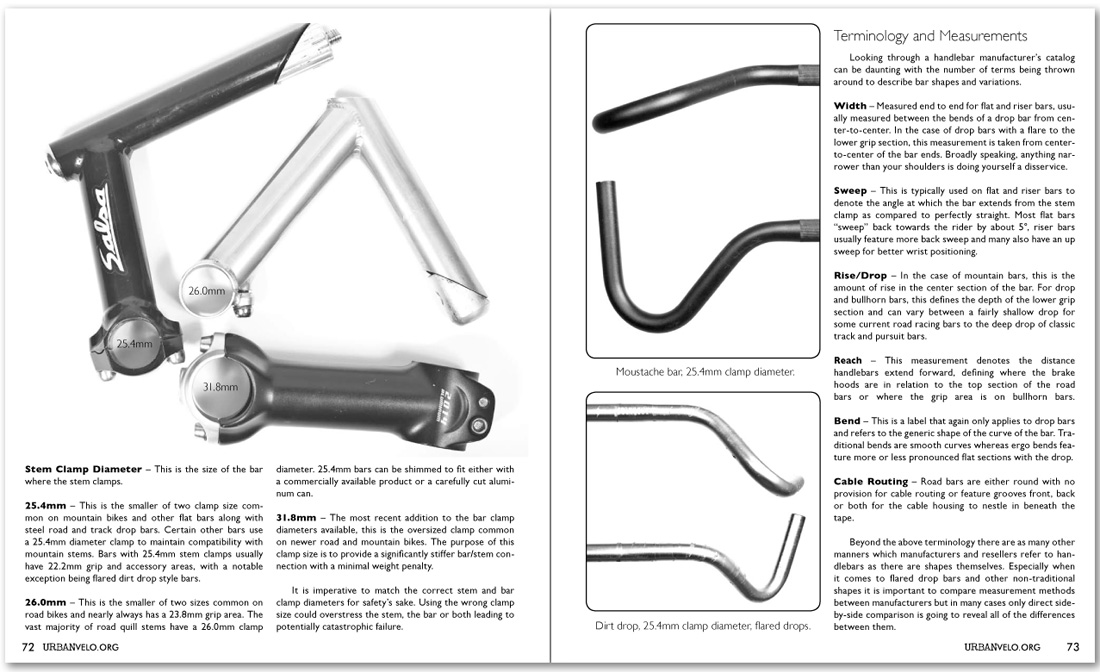Stem Clamp Diameter – This is the size of the bar where the stem clamps.
25.4mm – This is the smaller of two clamp size common on mountain bikes and other flat bars along with steel road and track drop bars. Certain other bars use a 25.4mm diameter clamp to maintain compatibility with mountain stems. Bars with 25.4mm stem clamps usually have 22.2mm grip and accessory areas, with a notable exception being flared dirt drop style bars.
26.0mm – This is the smaller of two sizes common on road bikes and nearly always has a 23.8mm grip area. The vast majority of road quill stems have a 26.0mm clamp diameter. 25.4mm bars can be shimmed to fit either with a commercially available product or a carefully cut aluminum can.
31.8mm – The most recent addition to the bar clamp diameters available, this is the oversized clamp common on newer road and mountain bikes. The purpose of this clamp size is to provide a significantly stiffer bar/stem connection with a minimal weight penalty.
It is imperative to match the correct stem and bar clamp diameters for safety’s sake. Using the wrong clamp size could overstress the stem, the bar or both leading to potentially catastrophic failure.
Terminology and Measurements
Looking through a handlebar manufacturer’s catalog can be daunting with the number of terms being thrown around to describe bar shapes and variations.
Width – Measured end to end for flat and riser bars, usually measured between the bends of a drop bar from center-to-center. In the case of drop bars with a flare to the lower grip section, this measurement is taken from center-to-center of the bar ends. Broadly speaking, anything narrower than your shoulders is doing yourself a disservice.
Sweep – This is typically used on flat and riser bars to denote the angle at which the bar extends from the stem clamp as compared to perfectly straight. Most flat bars “sweep” back towards the rider by about 5°, riser bars usually feature more back sweep and many also have an up sweep for better wrist positioning.
Rise/Drop – In the case of mountain bars, this is the amount of rise in the center section of the bar. For drop and bullhorn bars, this defines the depth of the lower grip section and can vary between a fairly shallow drop for some current road racing bars to the deep drop of classic track and pursuit bars.
Reach – This measurement denotes the distance handlebars extend forward, defining where the brake hoods are in relation to the top section of the road bars or where the grip area is on bullhorn bars.
Bend – This is a label that again only applies to drop bars and refers to the generic shape of the curve of the bar. Traditional bends are smooth curves whereas ergo bends feature more or less pronounced flat sections with the drop.
Cable Routing – Road bars are either round with no provision for cable routing or feature grooves front, back or both for the cable housing to nestle in beneath the tape.
Beyond the above terminology there are as many other manners which manufacturers and resellers refer to handlebars as there are shapes themselves. Especially when it comes to flared drop bars and other non-traditional shapes it is important to compare measurement methods between manufacturers but in many cases only direct side-by-side comparison is going to reveal all of the differences between them.
